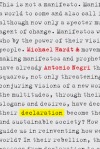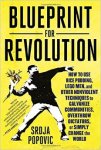If Zhou Enlai’s famous (if possibly apocryphal) comment about the impact of the French Revolution–it’s “too soon to say”–tells us that Revolutions can only be evaluated and understood over the long term, this is surely as true of their origins as of their legacies. To put this another way: it’s as hard to determine when a Revolution starts as it is to know when it has come to an end. At issue here is (again) the temporality of Revolution and its relation to history. One view is the revolutions are events, punctual interventions in history that transform or even overturn our sense of historical destiny. Hence they can be dated, often quite precisely: 1776 (the USA); October 1917 (Russia); January 1, 1959 (Cuba); July 17, 1979 (Nicaragua). These dates are historical caesurae. They mark the points at which the old order collapses and the new begins. As such, they slice up history: nothing afterwards is quite the same as what went on before.
Another view is that revolutions are best seen as processes. 1776, 1917, 1959 (etc.) mark only the beginnings of a series of changes that have their own histories and may advance or be betrayed, depending on the balance of forces and struggles that continue long after the initial taking of power. But surely these dates also mark the culmination of (perhaps) increasingly coordinated efforts to up-end the status quo and bring about new forms of society. Sometimes key events are cited as precursors. For colonial North America, for instance, the 1773 “Boston Tea Party” is celebrated as a key moment in the movement that led to independence. In a rather different way, for Russia the Revolution has been dated from Lenin’s arrival at the Finland Station in April 1917. But in each case perhaps it would be better to look further back: for instance to the formation of the “Sons of Liberty” in 1765 for the Thirteen Colonies, or to the establishment of the Bolshevik party in 1903 for what would become the USSR. But the establishment of these groups was itself the outcome of prior discontent and protest. How far back do you go?
In El Salvador, for instance, we might say that the (ultimately, failed) revolution there began with the creation of the FMLN in October, 1980, or with the formation of its constituent parts as small, revolutionary groups in the 1960s and 1970s. Alternatively, it’s arguable that the movement led by the FMLN in the 1980s began in 1932 (with the failed Communist uprising in the West of the country), in 1832 (with Anastasio Aquino’s indigenous revolt against the postcolonial creole elite), or even in 1524 (with resistance to the Spanish conquest at the Battle of Acajuctla). And other Latin American countries have similar histories of resistance and rebellion, to which subsequent revolutionary groups often pay homage in the names they choose for their organizations: the Salvadoran Farabundo Martí National Liberation Front, for instance, honours a hero of 1932; the Uruguayan Tupamaros gesture to the 1780 revolt against the Vice Royalty of Peru, led by Túpac Amaru II; and in Nicaragua, the Sandinista National Liberation Front commemorates Augusto Sandino and his resistance to the country’s occupation by US Marines in the 1920s and 1930s.

It is in this context, then, that we can understand the aim of Omar Cabezas’s Fire from the Mountain: it sets out, consciously or otherwise, to establish the Sandinistas’ historical legitimacy. For, especially from the point of view of outsiders, the Nicaraguan Revolution appeared to come from nowhere. The final campaign that brought down the dictator Somoza was astonishingly brief, a matter of months rather than years. Previously, the FSLN had been known only for what was in effect merely a relatively high-profile publicity stunt: taking a number of prominent hostages as a house party in December 1974, a feat that they successfully repeated, on a grander scale, at the Nicaraguan Congress in August 1978, less than a year before their eventual triumph. Otherwise, though founded in 1961, the Sandinistas were effectively unknown–not surprisingly, as for more than a decade their numbers never rose much above a few hundred, they represented hardly any military threat to the regime, and they were consistently on the verge of being wiped out by Somoza’s security forces.
Yet Fire from the Mountain is dedicated to this period when the FSLN was unheralded, marginal, and ineffective, rather than to their tumultuous final campaign and ultimate victory. It’s notable, for instance, that in the entire period of his guerrilla experience that the book covers, Cabezas never sees combat and not once does he fire his gun in anger. Indeed, it’s not clear that he fires his gun at all, except to kill a monkey to eat. The nearest he comes to direct action is when, encircled by the National Guard, he and a fellow Sandinista “backed off, firing two shots, and started running like hell” (166). Meanwhile, the book charts what could be described as a series of catastrophes and failures, including the death of one of the more prominent guerrillas in the aftermath of the only armed action that is described (at a distance), the shambolic break-up of a training camp for which Cabezas is military director, and most significantly what is in effect the annihilation of the group’s entire network of collaborators and safe houses in the North of the country. So when at one point the revolutionaries’ entire Northern leadership shows up at a house in the middle of the night (175), it is because there is basically nobody else left, and they have nowhere else to go.
None of this matters, however, and not merely because the book was written and published (in 1982) well after the Sandinistas’ eventual triumph. The point is that the narrative ends not with the revolutionary victory itself, but with the moment at which Cabezas (feels that he) can establish a continuity with the struggle of Sandino himself, forty years earlier. This comes just after Cabezas writes at length of a feeling of historical disjuncture, that the FSLN exists somehow outside of history, when he notes that life for his hometown (León), his mother, and the rest of his family goes on regardless while he is up in the hills: “León and my house had continued on quite independently of whether I was there or not. [. . .] That confused me. I had lost my bearings in space and time” (214). He continues: “I came from somewhere else, from living something else. Something snapped–my head was a whirl of space and time that I couldn’t get straightened out. What I did feel was my own absurdity. Because I couldn’t make sense of the two dimensions of time” (215). Revolutionary time and historical time seem at odds in this profound crisis, which is only resolved subsequently, when Cabezas meets an elderly peasant, Don Leandro, who had fought with Sandino himself some two generations previously.
At first it is Don Leandro’s sense of temporality that seems decidedly shaky. He sees Cabezas’s pistol and asks “what did you do with the other weapons” (217) only for it to emerge that he is talking about Sandino’s own weapons. “For him, that moment he had preserved and which had grown old was an instant that lasted forty years” (217). But it is precisely the longevity of this “instant” that enables a connection between the guerrillas of the 1970s and the original Sandinistas to whom their name gives homage. Cabezas tells us all of a sudden that he is now “touching Sandino [. . .] touching history” (218). The time of the revolution can now be aligned with historical time, as a filial continuity is established between old Don Leandro and Cabezas himself, a fatherless son: “It was as if it had never been interrupted, as if all this were a continuation of what [Leandro] had lived through with Sandino. [. . .] I started to feel that Don Leandro was the father, and I realized that in fact he was the father. [. . .] And never did I feel more a son of Sandinismo, more a son of Nicaragua than at that moment” (218, 221). The FSLN thus establishes an origin and a historical justification for a contemporary struggle that otherwise seems misaligned with the time of the people, and of the city. They usurp a national temporality, making themselves heirs to history: “It was history, the honor of the people, the historical rebellion of the people.” No longer absurd, “that, in essence, was the reality” (220).
The revolution belatedly establishes its origin, only through the struggle itself–only, in other words, after the fighting has begun. But once that origin is established, then for Cabezas the battle is already won. There is no need to show the triumph of 1979. The point is to be able to assert that he “was walking on something concrete.” Cabezas continues: “I was rooted in the earth, attached to the soil, to history. I felt invincible” (221). With that, no more needs to be said, and the book comes to an end, because it has finally found its beginning.








